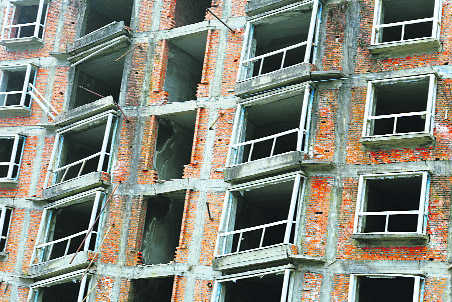Strong structures
Raj Kumar Aggarwal
Nepal and some parts of India have recently faced earthquakes of severe intensity that have caused extensive damage to life and property in Nepal. The tumbling down of historical monument Dhardhara Tower and other temples in Nepal has made all of us worried. Science can accurately predict floods and cyclones but not earthquakes. No such technique had been developed so far in the world to predict an earthquake. And it is a well known fact that it is the buildings that kill people and not an earthquake. Therefore it is necessary to take suitable measures for constructing quake-resistant buildings in government as well as in the private sector.
Faulty planning and inadequate structural design are the main factors that cause devastation during an earthquake. In order to check this only those buildings that have their design certified by qualified structural engineers should be approved.
Buildings or high-rises constructed with specified material grades and designs ensure that the structure moves as a single unit in the event of an earthquake and would absorb any impact due to uniformity of the structure. As high-rises are made of reinforced cement concrete and not bricks alone it makes them stronger.
Indian standard code suggests that building in earthquake zone should not be constructed on soft, silt or loose sand to avoid settlement, for such soils raft foundation is recommended. The brick masonry structure should not exceed three storeys (preferably it should be two storeys).
The purpose of quake-resistant buildings is to avoid sudden collapse due to diagonal tension and buckling on bond failure. To avoid this, the joint between the exterior column and beam should be provided with transverse column reinforcement as maximum moment due to quake occurs at this joint. To increase the ultimate strain in concrete and to improve the behaviour of beam in diagonal tension, rings in the beam should be spaced closely near the joint.
There is evidence wherein Jack Arch Roofs and tiled roofs have failed badly due to widening of gap between supporting two girders causing tiles/ bricks to fall during quakes. To prevent this, Jack Arch Roofs should be provided with mild steel bar ties in the end spans and in every fourth span where the number of spans are more.
We have to ensure the strict compliance of earth quake resistant building codes on all the buildings to be constructed in quake prone area to prevent Nepal-like disaster in future. Indian institutions have the highest degree of knowledge on quake resistant buildings after America and Japan. But to implement the same a strong will and suitable laws are required.
Here are some points that home builders as well as buyers should know about in order to check that the buildings being constructed are actually abloe to withstand an earthquake or not:
n Always keep foundation of the building on hard soil with proper width and depth not less than two feet six inches for a single-storey building.
n Use only good quality cement, bricks, steel and water during construction.
n Keep the shape of the building rectangular (the length should not be more than three times the breadth).
n Try to avoid unnecessary balconies, projections and cantilevers. These are more dangerous and collapse first during an earthquake.
n Bureau of Indian Standard strongly recommends (1:1.5:3) M-20 mix for all types of RCC work.
n All the walls of the buildings should be provided with reinforced cement concrete RCC band (beam) at the plinth level, door level and roof level on all the walls to act as one unit during earthquake.
n Construct multi-storey buildings with RCC column and beam-type construction (RCC framed structure).
n Spend more on structural safety than outer finish of the buildings and have safe buildings.
In the danger zone
Half of Punjab falls in seismic zone 4, which is extremely vulnerable. The MBT runs just north of it through Mandi and Chamoli areas of Himachal. According to experts Gurdaspur, Hoshiarpur, Amritsar, Tarn Taran, Kapurthala, Jalandhar, Nawanshehar, Ludhiana, Fatehgarh Sahib, Mohali & Ropar districts falls in zone 4, where as Ferozepore, Muktsar, Moga, Faridkot, Bathinda, Sangrur, Mansa, Patiala and Barnala districts falls in zone 3. So, 11 districts of Punjab will be badly hit in case of a high-intensity earthquake.
— The writer is working as Executive Engineer in Baba Farid University of Health Sciences, Faridkot










